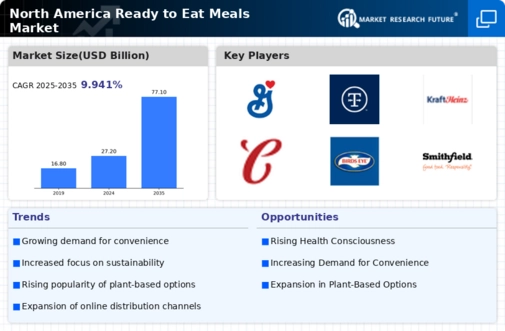The ready to-eat-meals market in North America is characterized by a dynamic competitive landscape, driven by evolving consumer preferences and an increasing demand for convenience. Major players such as Nestlé (CH), Unilever (GB), and Kraft Heinz (US) are strategically positioning themselves through innovation and product diversification. Nestlé (CH) has focused on expanding its portfolio to include plant-based options, catering to the growing health-conscious demographic. Unilever (GB) emphasizes sustainability in its operations, aiming to reduce its carbon footprint while enhancing product offerings. Kraft Heinz (US) is leveraging digital transformation to optimize its supply chain and enhance customer engagement, thereby shaping a competitive environment that prioritizes adaptability and responsiveness.
Key business tactics within this market include localizing manufacturing and optimizing supply chains to meet regional demands. The competitive structure appears moderately fragmented, with several key players exerting influence over market dynamics. This fragmentation allows for niche players to thrive, while larger corporations capitalize on economies of scale and brand recognition. The collective influence of these companies fosters a competitive atmosphere where innovation and operational efficiency are paramount.
In October 2025, Nestlé (CH) announced a partnership with a leading technology firm to develop AI-driven meal customization tools, enhancing consumer engagement through personalized nutrition. This strategic move is likely to position Nestlé (CH) at the forefront of the digital transformation trend, allowing for tailored meal solutions that resonate with individual dietary preferences. Such initiatives may not only drive sales but also strengthen brand loyalty among health-conscious consumers.
In September 2025, Unilever (GB) launched a new line of ready-to-eat meals that are entirely plant-based, reflecting its commitment to sustainability and health. This initiative aligns with the increasing consumer shift towards plant-based diets, potentially capturing a significant market share. By prioritizing environmentally friendly practices, Unilever (GB) is likely to enhance its brand image and appeal to a broader audience concerned with sustainability.
In August 2025, Kraft Heinz (US) unveiled a new digital platform aimed at streamlining its supply chain processes, which is expected to improve operational efficiency and reduce costs. This strategic action underscores the importance of technology in enhancing supply chain reliability, a critical factor in maintaining competitive advantage. As consumer expectations for quick and reliable delivery continue to rise, such innovations may prove essential for sustaining market relevance.
As of November 2025, current trends in the ready to-eat-meals market indicate a strong emphasis on digitalization, sustainability, and AI integration. Strategic alliances among key players are shaping the landscape, fostering collaboration that enhances innovation and operational capabilities. Looking ahead, competitive differentiation is likely to evolve, shifting from price-based competition to a focus on innovation, technology, and supply chain reliability. Companies that successfully navigate these trends may secure a more robust market position, ultimately redefining consumer expectations in the ready to-eat-meals sector.


















Leave a Comment